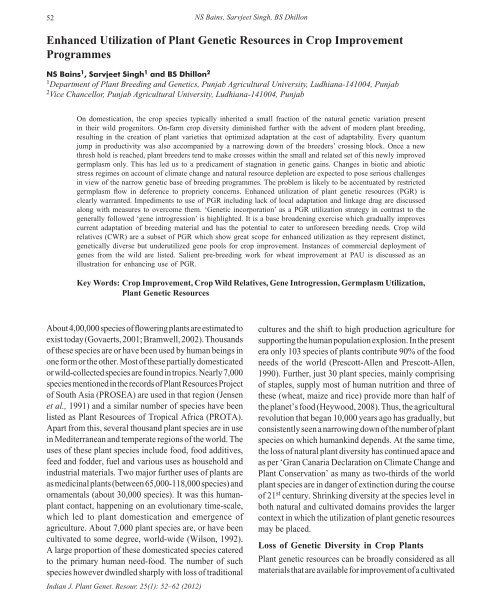indian society of plant genetic resources - Bioversity International
indian society of plant genetic resources - Bioversity International
indian society of plant genetic resources - Bioversity International
You also want an ePaper? Increase the reach of your titles
YUMPU automatically turns print PDFs into web optimized ePapers that Google loves.
52<br />
Indian J. Plant Genet. Resour. 25(1): 52–62 (2012)<br />
NS Bains, Sarvjeet Singh, BS Dhillon<br />
Enhanced Utilization <strong>of</strong> Plant Genetic Resources in Crop Improvement<br />
Programmes<br />
NS Bains 1 , Sarvjeet Singh 1 and BS Dhillon 2<br />
1 Department <strong>of</strong> Plant Breeding and Genetics, Punjab Agricultural University, Ludhiana-141004, Punjab<br />
2 Vice Chancellor, Punjab Agricultural University, Ludhiana-141004, Punjab<br />
On domestication, the crop species typically inherited a small fraction <strong>of</strong> the natural <strong>genetic</strong> variation present<br />
in their wild progenitors. On-farm crop diversity diminished further with the advent <strong>of</strong> modern <strong>plant</strong> breeding,<br />
resulting in the creation <strong>of</strong> <strong>plant</strong> varieties that optimized adaptation at the cost <strong>of</strong> adaptability. Every quantum<br />
jump in productivity was also accompanied by a narrowing down <strong>of</strong> the breeders’ crossing block. Once a new<br />
thresh hold is reached, <strong>plant</strong> breeders tend to make crosses within the small and related set <strong>of</strong> this newly improved<br />
germplasm only. This has led us to a predicament <strong>of</strong> stagnation in <strong>genetic</strong> gains. Changes in biotic and abiotic<br />
stress regimes on account <strong>of</strong> climate change and natural resource depletion are expected to pose serious challenges<br />
in view <strong>of</strong> the narrow <strong>genetic</strong> base <strong>of</strong> breeding programmes. The problem is likely to be accentuated by restricted<br />
germplasm fl ow in deference to propriety concerns. Enhanced utilization <strong>of</strong> <strong>plant</strong> <strong>genetic</strong> <strong>resources</strong> (PGR) is<br />
clearly warranted. Impediments to use <strong>of</strong> PGR including lack <strong>of</strong> local adaptation and linkage drag are discussed<br />
along with measures to overcome them. ‘Genetic incorporation’ as a PGR utilization strategy in contrast to the<br />
generally followed ‘gene introgression’ is highlighted. It is a base broadening exercise which gradually improves<br />
current adaptation <strong>of</strong> breeding material and has the potential to cater to unforeseen breeding needs. Crop wild<br />
relatives (CWR) are a subset <strong>of</strong> PGR which show great scope for enhanced utilization as they represent distinct,<br />
<strong>genetic</strong>ally diverse but underutilized gene pools for crop improvement. Instances <strong>of</strong> commercial deployment <strong>of</strong><br />
genes from the wild are listed. Salient pre-breeding work for wheat improvement at PAU is discussed as an<br />
illustration for enhancing use <strong>of</strong> PGR.<br />
Key Words: Crop Improvement, Crop Wild Relatives, Gene Introgression, Germplasm Utilization,<br />
Plant Genetic Resources<br />
About 4,00,000 species <strong>of</strong> fl owering <strong>plant</strong>s are estimated to<br />
exist today (Govaerts, 2001; Bramwell, 2002). Thousands<br />
<strong>of</strong> these species are or have been used by human beings in<br />
one form or the other. Most <strong>of</strong> these partially domesticated<br />
or wild-collected species are found in tropics. Nearly 7,000<br />
species mentioned in the records <strong>of</strong> Plant Resources Project<br />
<strong>of</strong> South Asia (PROSEA) are used in that region (Jensen<br />
et al., 1991) and a similar number <strong>of</strong> species have been<br />
listed as Plant Resources <strong>of</strong> Tropical Africa (PROTA).<br />
Apart from this, several thousand <strong>plant</strong> species are in use<br />
in Mediterranean and temperate regions <strong>of</strong> the world. The<br />
uses <strong>of</strong> these <strong>plant</strong> species include food, food additives,<br />
feed and fodder, fuel and various uses as household and<br />
industrial materials. Two major further uses <strong>of</strong> <strong>plant</strong>s are<br />
as medicinal <strong>plant</strong>s (between 65,000-118,000 species) and<br />
ornamentals (about 30,000 species). It was this human<strong>plant</strong><br />
contact, happening on an evolutionary time-scale,<br />
which led to <strong>plant</strong> domestication and emergence <strong>of</strong><br />
agriculture. About 7,000 <strong>plant</strong> species are, or have been<br />
cultivated to some degree, world-wide (Wilson, 1992).<br />
A large proportion <strong>of</strong> these domesticated species catered<br />
to the primary human need-food. The number <strong>of</strong> such<br />
species however dwindled sharply with loss <strong>of</strong> traditional<br />
cultures and the shift to high production agriculture for<br />
supporting the human population explosion. In the present<br />
era only 103 species <strong>of</strong> <strong>plant</strong>s contribute 90% <strong>of</strong> the food<br />
needs <strong>of</strong> the world (Prescott-Allen and Prescott-Allen,<br />
1990). Further, just 30 <strong>plant</strong> species, mainly comprising<br />
<strong>of</strong> staples, supply most <strong>of</strong> human nutrition and three <strong>of</strong><br />
these (wheat, maize and rice) provide more than half <strong>of</strong><br />
the planet’s food (Heywood, 2008). Thus, the agricultural<br />
revolution that began 10,000 years ago has gradually, but<br />
consistently seen a narrowing down <strong>of</strong> the number <strong>of</strong> <strong>plant</strong><br />
species on which humankind depends. At the same time,<br />
the loss <strong>of</strong> natural <strong>plant</strong> diversity has continued apace and<br />
as per ‘Gran Canaria Declaration on Climate Change and<br />
Plant Conservation’ as many as two-thirds <strong>of</strong> the world<br />
<strong>plant</strong> species are in danger <strong>of</strong> extinction during the course<br />
<strong>of</strong> 21 st century. Shrinking diversity at the species level in<br />
both natural and cultivated domains provides the larger<br />
context in which the utilization <strong>of</strong> <strong>plant</strong> <strong>genetic</strong> <strong>resources</strong><br />
may be placed.<br />
Loss <strong>of</strong> Genetic Diversity in Crop Plants<br />
Plant <strong>genetic</strong> <strong>resources</strong> can be broadly considered as all<br />
materials that are available for improvement <strong>of</strong> a cultivated

















